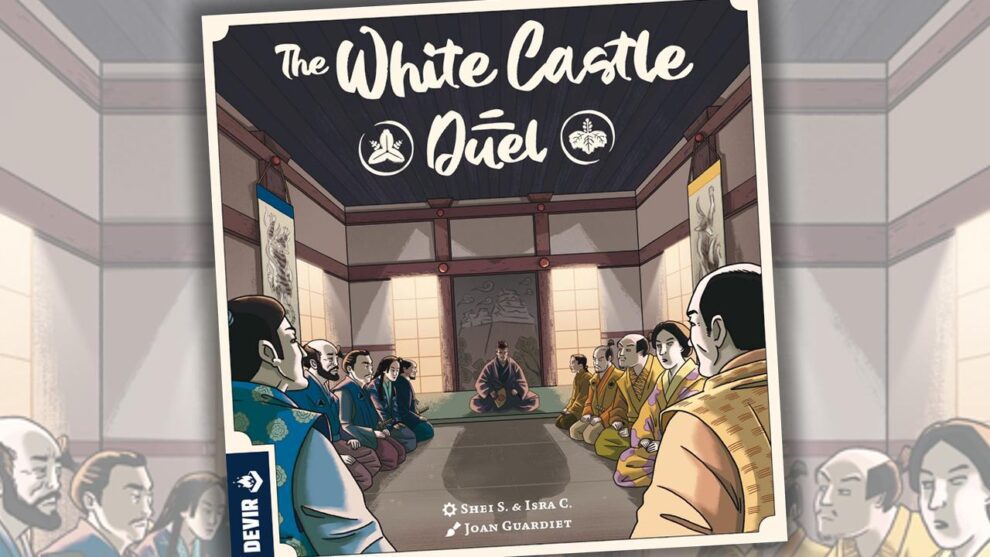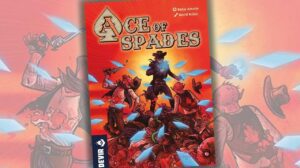Disclosure: Meeple Mountain received a free copy of this product in exchange for an honest, unbiased review. This review is not intended to be an endorsement.
Between in-person plays of The White Castle (2023, Devir), the expansion The White Castle: Matcha, and online plays of the base game on Board Game Arena, I’ve now played a game in the system of The White Castle over a hundred times, making it the most-played game in my collection. My highest score in the base game is 105 points; when I first got the game, I was struggling to even score 40 points. Getting beaten by the solo bot and a lot of other players has taught me quite a bit!
The White Castle is one of the very few games I find to be exceptional at all player counts, even solo. With two players, the base game is a very solid experience that my wife and I can play in about 30 minutes. For something with only nine turns, it is still amazing to me how much game The White Castle has in the box for such a short turn structure (and such a great price).
Over the last few years, “The Hobby” has spoken…and apparently, every successful game needs its own two-player-only format. Therefore, it was not a surprise when The White Castle Duel arrived on my doorstep. I’m a big fan of Devir’s catalog, and I’m a massive fan of the Devir games designed by Llama Dice, the design duo who not only gave us the other games in this series, but who also designed The Red Cathedral.
Here’s what is a surprise: The White Castle Duel is good, but I still prefer The White Castle base game at two players over the dedicated two-player Duel version. Let me explain.
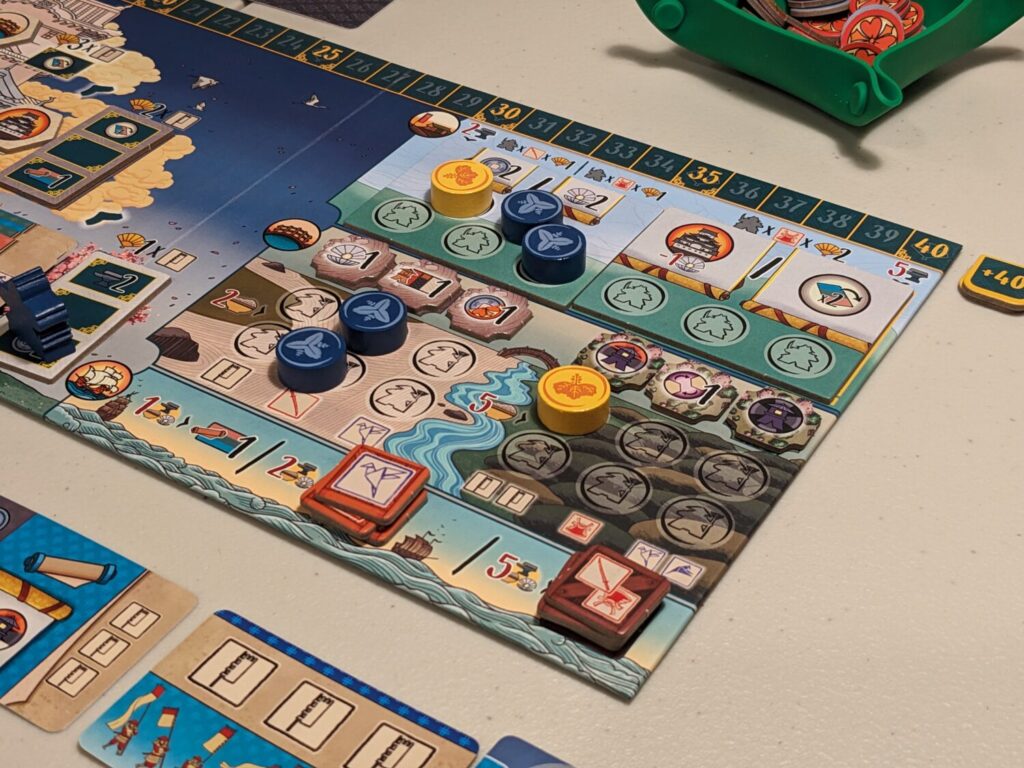
Llamas? Yes. Dice? No
The White Castle Duel is an action selection game for two players; it plays in 30-45 minutes. While it is based on The White Castle, Duel is a different game, one with a number of subtle differences here that warrant their own sidebar.
The White Castle is a dice worker placement game. In each of the game’s nine turns, players select one of the six-sided dice from one of three dice bridges (in coral, black, or white) to trigger an action for that turn. If they selected a die from the left end of one of those bridges, they also trigger a small series of income actions known as the Lantern, which becomes one of the juiciest parts of the game’s optimization puzzle as players spend resources to navigate one of the three main actions in the game (Gardener, Warrior, Courtier). At the end of the third and sixth turns, there is an income phase that is a crucial avenue to gain additional resources and get more of a player’s pieces on the board, before final scoring after the ninth and final turn of the game.
The White Castle Duel removes the dice altogether. This, alone, drove down my level of excitement. I’m a dice guy, born and raised. I like chucking dice. I like dice combat games. I like gambling by pushing my luck with dice, at least in board games. I like dice as worker placement games. I like dice drafting games. Generally, dice are a net positive for me, so just discovering that The White Castle Duel had no dice was a minor gut punch. I want my dice, so don’t deny me what I love!
Surprisingly, the lack of dice in this new duel variant is fine once the game gets going. That’s because the new systems are fun, and turns are still interesting, if just a little less thinky. In The White Castle Duel, each player begins the game with six Lantern tokens, two in each of the base game’s three colors: coral, black, and white. Those tokens can be placed on an empty Location tile or atop another token at a Location that is different in color than the one being stacked to take exactly two actions. Those actions are the Activation tiles—randomly placed during setup—to the left and the right of the Location tile.
The 12 rounds of The White Castle Duel are split in half, with players placing their six Lantern tokens onto spaces in the first half, then removing them from stacks to place them back on their player board in the second half. I loved the flexibility that comes with these rules, because players do not have to take back an equal number of coral, black, and white Lantern tokens in the second half of the game. In my first play, I took back all four coral tokens because that was my best lantern engine. This means a player doesn’t have to necessarily diversify when building their engine, which I thought was a nice touch.

The base game’s three actions—Gardener, Warrior, Courtier—are still a part of The White Castle Duel, and are known here as Garden, Training, and Courtier. (I don’t know why some of these action titles were changed, but I will selfishly say this was done simply to confuse me.) These actions allow a player to spend the same resource types present in the base game (food, iron, and mother-of-pearl, respectively) to take those actions and drop the new Clan Seal tokens on spaces or tracks to get rewards.
Three new actions have been added. One, simply called Lantern, triggers a player’s lantern income area of their choice, while a new action called Trade with the Portuguese allows a player to buy cards or symbol tokens factored into endgame scoring. (While Trade sometimes leads to a player spending a single resource to buy an Influence card they want at its normal price, we have already found the Trade action is typically used as a bailout action late in games, when players can spend leftover resources to acquire extra symbols.)
The Influence cards are quite a wild card in the design of the Duel variant. Influence cards can be purchased for coins and/or Daimyo seals, if there is a card slot adjacent to where a player placed their Lantern token that turn. Some cards can be bought for a single coin and provide resources and cards that can be inserted into a player’s income engine. Others cost more, and offer a chance to take one of the game’s six main actions at a discount.
All Influence cards have symbols that are used to multiply the progress made on the game’s three main actions to score points at the end of the game—but only when a player uses the 2x Improve action, to flip Influence cards to their scoring side. (A number of Influence cards, track spaces, and rewards on the board offer the Improve action as well, in 1x and 2x formats to allow a player to flip one or two of their Influence cards.)
All of this felt like The White Castle Duel might make this version of the game more complicated than the base game when I first read the rules, but that turned out to be incorrect. In fact, the rules, and the level of difficulty almost across the board, seems to be lighter in tone than the base game. While that ended up being a net negative for me, I think it will be a net positive for most players, particularly those who are new to The White Castle gaming system.

A Friendlier Experience
The White Castle Duel is still a good puzzle, and it still produces a tight experience. It’s just not the type of “tight” I fell in love with during dozens of plays of the base game.
Even during my first play, my opponent was able to get all eight of his Clan Seals onto the board, get his courtier token to the top of the castle (here, like in the base game, called the “Social Climbing” track), and line up a series of very handsome moves. Interaction is lighter in this version of the system. In the base game, a two-player game can be very “snipe-y”, because space is so limited and a player in need of high pip value dice might only find one or two in a round, based on the random nature of how each set of three turns begins.
This could mean great news for players who felt The White Castle was too tight, occasionally too mean, and/or too challenging to manage a stable amount of coins and seals. In a surprising twist, The White Castle Duel is a little longer than the base game. It is never boring, with each player taking 12 main turns and a variety of minor actions (due, in part, to actions on the Influence cards), giving each player a chance to do a lot in not very much time.
But I found myself constantly dreaming about the base game while taking my turns. The lantern areas on player boards in The White Castle Duel have tripled in size, with one lantern aligned with each lantern income track color (coral, black, white) on their player board. These tracks can be built using a new mechanic that lets players simply take cards from a face-up market near the board. That’s great, but I prefer the version in the base game, in part because the decision on which card to move from the castle to a player’s personal board is such an important choice.
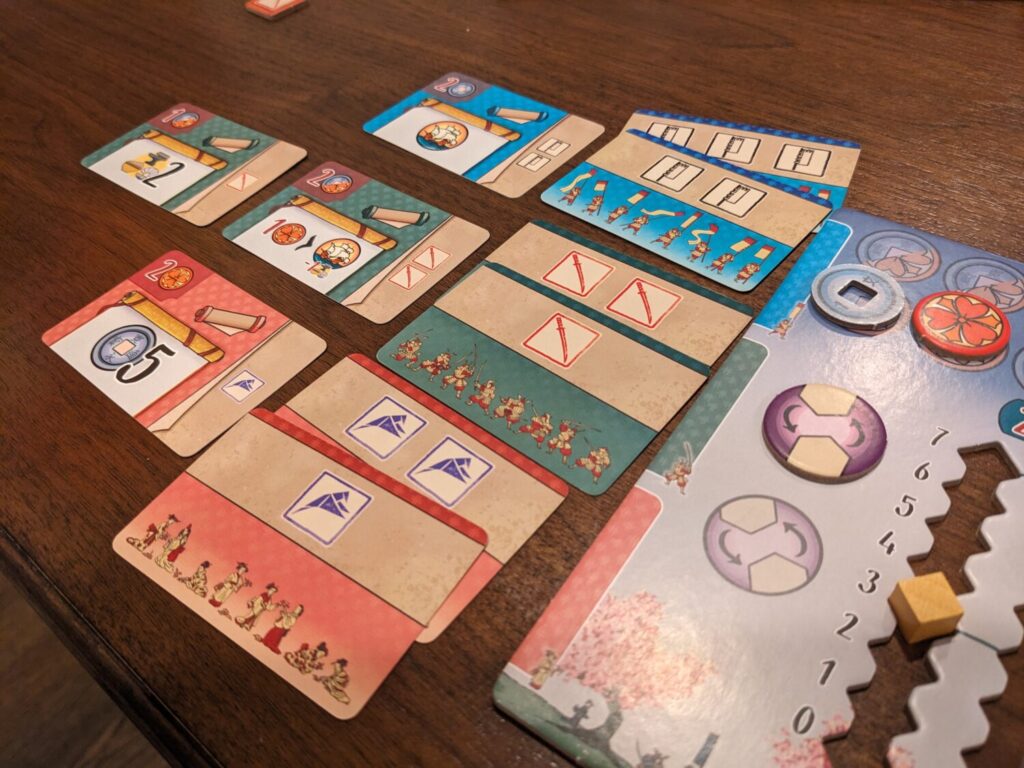
I prefer drafting the right dice in the base game as a way to drive the game forward. Money can be really tight in the base game, and getting the right dice at the right time (particularly in a round where most of the die rolls have come in low) is so crucial. Money is a bit loose in The White Castle Duel, and it always felt like I could find a way to get more coins and/or seals, so running out of money on one turn is not nearly as crippling as it can be in the base game.
One of the major negatives of this version of the game is tied to the variable setup along with the randomized nature of how Influence cards appear in each play. When there are limited chances to acquire lantern cards, The White Castle Duel is not as much fun. During setup, players must randomly place one Basic Training Yard tile and one Elite Training Yard tile in the Training area. Only one of the four tiles available for each yard features a bonus of adding a lantern card to a player’s engine.
In games where those tiles are included, The White Castle Duel is just better, because players are getting more juice every time they trigger their income. The game’s Garden area also has a randomized setup, but only one of the eight available tiles has a bonus of lantern cards, and because those Garden bonus tiles are double-sided, there’s a chance that you won’t see a lantern bonus included in that area of the board. The Courtier bonus track has more options to add lantern tiles, depending on the sides used during setup.
That means you might try to do what I now do during setup: I don’t “randomize” it at all, to ensure that lantern bonuses magically appear in all areas of the board. If you do this, you’ll have a much better chance at higher scores, because resources, money, Daimyo seals, and points will be featured much more prominently in your plays. (That 40+/80+ point token from the base game returns in the Duel version…but I really can’t imagine players tapping 80+ points without a seriously robust lantern engine.)
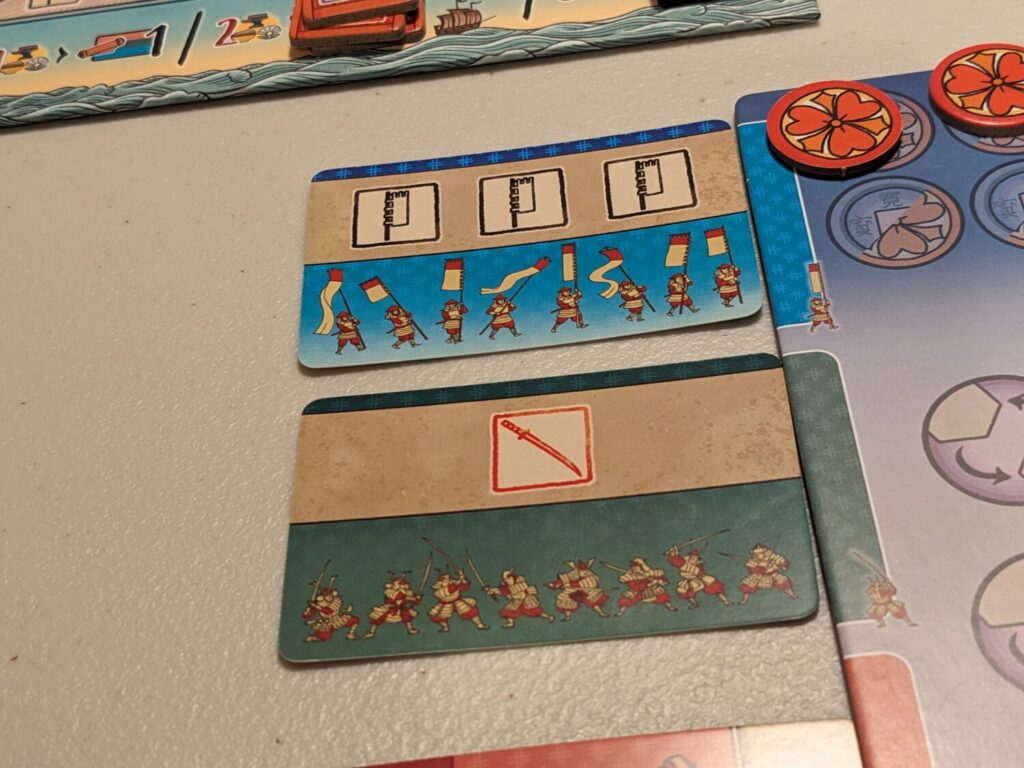
There’s a Place for Both
The White Castle Duel is, for many of the players in my network, the better on-ramp to the system. At no point is The White Castle Duel a game I would consider “cutthroat.” It is definitely a different flavor than what’s on offer in the base game. It’s a friendlier, looser version of the system, and while it is a little longer than the base game, turns are usually quick and players will need a minute or two to consider their next move, especially in the back half of the game.
The White Castle Duel still has combos. It still has many interesting decisions. It’s still a handsome production in a surprisingly small box, although I wish Devir and the designers used different tokens to serve as the Location placement spaces, because the Location tiles don’t stand out the way dice placement spaces stand out in the base game. And even with the cheats I offered above during setup, it’s still a challenge to surpass 80 points, the high-water mark of stellar play no matter which The White Castle title you are playing.
For a serious gamer, or a junkie who loves the base game as much as I do, I think you are better served sticking with the base game even if you usually play games with only two players. I have never wavered, and this new duel variant has cemented my thinking: while I personally prefer playing The White Castle at its full player count of four, it is excellent with two players. Ironically, The White Castle base game at two players feels more like a “duel” than The White Castle Duel. The base game feels like a very tightly-orchestrated battle between two rivals, whereas The White Castle Duel feels more like a friendly race in the backyard on a Saturday afternoon.
Beyond that, my only question mark regarding the experience is the use of coins and Daimyo seals in The White Castle Duel. In the base game, seals are strictly better than coins, because a seal can be used as a coin, and not vice versa. In both games, players can freely trade two Daimyo seals for one resource (food, iron, mother-of-pearl). But in The White Castle Duel, it seems clear in the rulebook that while only seals can be traded for resources, seals cannot take the place of coins any longer.
For base game junkies, that means you will do what I did—you will get this rule wrong when paying for Influence cards in The White Castle Duel. When a card in Duel asks for coins as payment, you CANNOT use seals as a substitute like you could in the base game. After getting this wrong during my first play, I got it right in successive plays.
I’m not sure why this rule was changed, or if this was the intent of the designers to change the rule to make The White Castle Duel different. I scoured the rulebook for The White Castle Duel multiple times and never found evidence that one could swap coins for seals. This doesn’t make the game any harder, because we found coins and seals to be relatively easy to gain throughout play, it simply serves to confuse players who are familiar with The White Castle and its systems.
At the end of the day, both games are fun. But only one of them has dice, so I’m sticking with that one!


